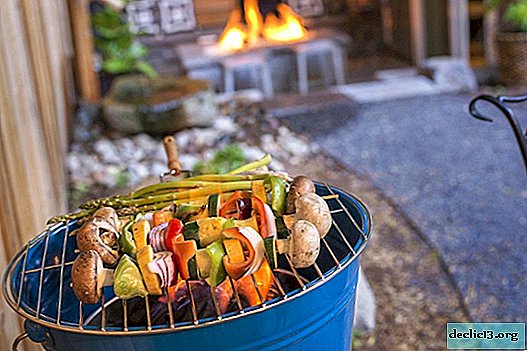An unusual way of propagating roses is the burrito method. Pros and cons, step-by-step instructions and possible problems

The propagation of roses by the burrito method is a method of vegetative propagation (cuttings), in which the formation of roots on the cuttings occurs due to their wrapping in a wet newspaper. The name of the method comes from the Mexican word for a dish very similar to non-shawarma.
It consists of a tortilla, in which a different filling is wrapped. The role of such a “cake” is played by a wet newspaper, and the “filling” is rose cuttings for which rooting is necessary. Inside the convolution, ideal conditions are created for the formation of callus on them. This is a white outgrowth of special cells on the surface of the stem. They are an analogue of human stem cells, since any tissue can form from them in the future. In the case of cuttings, roots grow from callus over time.
Advantages of the unusual method of cutting
- Compared to other methods, the percentage of roots on the cuttings is very high. Hard-rooted varieties are much easier to propagate by this method.
- The ability to control rooting visually. This is a huge plus compared to the method when the cuttings are immediately planted in the ground. Here you can check how the roots grow, and throw away cuttings that have deteriorated in time.
- At any time, you can intervene and create the most optimal conditions, that is, adjust the humidity, ventilate the cuttings, and create an optimal temperature regime for them.
- This method makes it possible to grow rose seedlings in the middle of winter.
Disadvantages
The main rejection of cuttings occurs precisely at the time of their transplantation into the ground. This happens for the reason that initially they are completely not adapted to the ground. Therefore, all or very many cuttings can let out the roots, but only a part will take root after landing in the ground.
When to choose this method, and when not?
 The main task is to choose the right planting material. Therefore, this method is not used in the summer, since rose cuttings have not yet ripened, they have a thin bark, they can not stand a long stay in a wet newspaper and rot.
The main task is to choose the right planting material. Therefore, this method is not used in the summer, since rose cuttings have not yet ripened, they have a thin bark, they can not stand a long stay in a wet newspaper and rot.
Chic huge Dutch roses on long stems cannot be planted. Therefore, do not rush to cut a gift bouquet on the cuttings. These roses are not adapted to our climate. Even if you are lucky and they will release the roots, they will not take root in the ground.
This method is suitable for propagating roses from your garden, or you can ask your gardeners for familiar cuttings. That is, for propagation in an unusual way, burritos are suitable varieties that are adapted to our climate and tolerate wintering well.
Application at different times of the year
Cuttings in autumn:
- After the autumn pruning of roses, there are many cuttings that should not be thrown away, they can easily be turned into new bushes using this method.
- It is in the fall that the quality of cuttings is the best, since they have matured, they have the thickest bark.
- There is a good supply of time, since cuttings will probably be rooted by spring. Over the summer, they take root well, so they will tolerate wintering well provided that they are properly protected from frost.
- If you apply this method to cuttings cut in early autumn, it may be necessary to plant them in pots, as they released the roots, but it is too early to plant them in open ground.
- If desired, autumn cuttings can not be immediately rooted, but stored in the refrigerator, wrapped in dry paper and a plastic bag with holes. If there are a lot of cuttings, they are put in a cardboard box and stored on the balcony or in the cellar (if they do not freeze in winter).
In winter:
- Late varieties of roses, which bloom all summer and the first half of autumn, are cut off by some gardeners at the end of November, or even at the beginning of winter. These cuttings can be used for breeding using the burrito method.
 This is especially true for regions where winters are warm and there is no snow in early December, or even the entire first month of winter.
This is especially true for regions where winters are warm and there is no snow in early December, or even the entire first month of winter.- By spring, cuttings should be well rooted.
- There is less risk that they will release so large roots that they will have to be planted in pots at home, and transplanted into the ground in spring. Winter cuttings may well wait until spring, when they are planted in open ground in a permanent place.
In the spring:
- As cuttings take only the ripened old shoots.
- After they release the roots, they are immediately planted in the ground, there is no need to grow them in pots in the house.
Step-by-step instruction
- Inventory preparation. A sharp clean secateurs or knife are needed. Newspapers and plastic bags are also needed.
- Cutting cuttings. The length of the cuttings should be about 20 cm, and the thickness is 4-5 mm, that is, approximately with a pencil. They should have at least three sleeping kidneys. Trim them from the middle of the shoot. Be sure to inspect the cuttings so that they are with a smooth bark without damage. If they have rot, spots, they are not suitable for reproduction. From cut cuttings remove all petioles, leaves.
The thickness of cut cuttings is very important, you can not take thinner and shorter than the indicated sizes. They should retain enough nutrients for rooting, otherwise they will simply dry out.
- Cutting Processing. If these are autumn cuttings, and they were stored for some time in the refrigerator or on the balcony, you need to update the cut with a sharp knife.
In a plate with filtered water at room temperature, a preparation is diluted to stimulate root formation in the dosage indicated on the package. Immerse the cuttings a third of the length and stand for 6 hours. If it is not possible to purchase such a drug, it can be replaced with aloe juice diluted in water in a ratio of 1: 9, or honey (a teaspoon per 0.5 l of water).
After this, handle the cuttings with a fungicidal preparation to exclude the likelihood of fungus formation.
 Newspaper packaging and bag. Cuttings are taken in 4-7 pieces and wrapped in a newspaper, folded in several layers. It is necessary to wrap it completely, the edges should not peek out. Then the newspaper must be wetted with water so that it becomes wet, but does not fall apart. Excess water should drain from the newspaper. After this, the bundle is wrapped in a plastic bag. If there are no newspapers, they can be replaced with paper towels.
Newspaper packaging and bag. Cuttings are taken in 4-7 pieces and wrapped in a newspaper, folded in several layers. It is necessary to wrap it completely, the edges should not peek out. Then the newspaper must be wetted with water so that it becomes wet, but does not fall apart. Excess water should drain from the newspaper. After this, the bundle is wrapped in a plastic bag. If there are no newspapers, they can be replaced with paper towels.- Waiting and checking the result. The bundles with cuttings are stored in a cool place where the air temperature is + 14-18 °. This temperature regime is most favorable for the formation of callus. If the apartment is hot, it is better to store the packages somewhere else.
You need to check them once a week. The newspaper is carefully unfold and inspect the cuttings. If mold or rot begins to form, the entire package must be discarded. If necessary, the newspaper must be moistened, it must not be allowed to dry completely. Every two weeks should be treated with fungicide.
Callus appears after 2-4 weeks. It will be immediately noticeable, it looks like sagging on the surface of the cuttings, roots will form from them.
- Planting sprouted cuttings. After the appearance of a full callus and the first roots, the cuttings are planted one at a time in small pots or jars. It is better to buy a special soil, which is designed for roses.
Important! It is necessary to plant the stalk so that the upper bud rises above the surface of the soil, and the rest are in the ground.
A jar or pot should be packaged in a bag, creating the effect of a water bath. The temperature in the room should not be lower than + 23 °, so that the cuttings take root. A package with sprouting cuttings must often be opened, a little ventilated, sprayed and watered. You can not turn the soil into non-drying mud, but the complete drying of the earth will lead to the death of the cuttings. As the cuttings grow, the package is ajar.
- Rooting seedlings. Rooted cuttings in pots are planted in open ground in late spring, when night frosts are guaranteed to be over. Reference. If the spring cuttings were propagated by the burrito method, then after the appearance of the roots, they can be immediately planted in open ground and covered with a film, having arranged a small greenhouse.
The place must be chosen sunny and closed from the wind, even so that rainwater does not flood the seedlings. You can put some organic fertilizer in the planting pits. Before planting, the stems of the seedlings are cut, leaving 3-4 buds. After planting, seedlings must be watered and sprinkled with sawdust. It is also advisable to shade them from the scorching sun. After adaptation in the soil, the growth of seedlings will begin in 10-15 days.
- Further care of the young plant. After the young shoots grow by 12-15 cm, they can be fed with special fertilizer for roses with the frequency and dosage indicated on the package. In the first year, young bushes must take root, therefore, they should not be allowed to bloom, this will take a lot of strength from the plant. If buds appear, they must be cut immediately. In autumn, you need to provide young rose bushes with reliable shelter for the winter.
Possible problems and difficulties
 Callus is formed, but the process stops, the cuttings die - the reason lies in too low a temperature.
Callus is formed, but the process stops, the cuttings die - the reason lies in too low a temperature.- Cuttings dry up or prey - the temperature in the room is too high.
- The cuttings rot - they dampened the newspaper too profusely, high temperature and humidity in the room.
- Fungal or bacterial damage to the cuttings - no fungicide treatment was carried out.
- The cuttings planted in the soil rotted and died - too dense soil unsuitable for roses, preventing air from reaching the roots.
Alternatives
- Germination of the roots on the cuttings of roses, putting them in water. Callus is formed after 15-20 days of their constant stay in water, which is changed every 2 days for fresh.
- Propagation by layering - a branch of a rose that is close to the ground is nailed, cut and dug. By next year, she has developed its own root system.
- Propagation in potatoes - cut cuttings are stuck in potatoes and instilled. This provides them with nutrients and moisture until the root system appears.

 This is especially true for regions where winters are warm and there is no snow in early December, or even the entire first month of winter.
This is especially true for regions where winters are warm and there is no snow in early December, or even the entire first month of winter. Newspaper packaging and bag. Cuttings are taken in 4-7 pieces and wrapped in a newspaper, folded in several layers. It is necessary to wrap it completely, the edges should not peek out. Then the newspaper must be wetted with water so that it becomes wet, but does not fall apart. Excess water should drain from the newspaper. After this, the bundle is wrapped in a plastic bag. If there are no newspapers, they can be replaced with paper towels.
Newspaper packaging and bag. Cuttings are taken in 4-7 pieces and wrapped in a newspaper, folded in several layers. It is necessary to wrap it completely, the edges should not peek out. Then the newspaper must be wetted with water so that it becomes wet, but does not fall apart. Excess water should drain from the newspaper. After this, the bundle is wrapped in a plastic bag. If there are no newspapers, they can be replaced with paper towels. Callus is formed, but the process stops, the cuttings die - the reason lies in too low a temperature.
Callus is formed, but the process stops, the cuttings die - the reason lies in too low a temperature.















